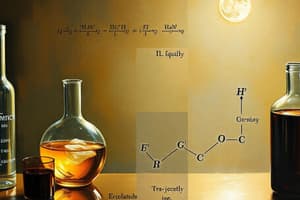Podcast
Questions and Answers
What is the purpose of balancing a chemical equation?
What is the purpose of balancing a chemical equation?
What is the equilibrium constant (K) a measure of?
What is the equilibrium constant (K) a measure of?
If Q > K, what will happen to the reaction?
If Q > K, what will happen to the reaction?
What is the role of stoichiometric coefficients in a chemical equation?
What is the role of stoichiometric coefficients in a chemical equation?
Signup and view all the answers
What is the state in which the rate of the forward reaction is equal to the rate of the backward reaction?
What is the state in which the rate of the forward reaction is equal to the rate of the backward reaction?
Signup and view all the answers
What is a characteristic of homogeneous equilibrium in chemical reactions?
What is a characteristic of homogeneous equilibrium in chemical reactions?
Signup and view all the answers
What is the purpose of balancing a chemical equation?
What is the purpose of balancing a chemical equation?
Signup and view all the answers
What is an example of a heterogeneous equilibrium reaction?
What is an example of a heterogeneous equilibrium reaction?
Signup and view all the answers
What is a characteristic of chemical reactions with equal number of molecules of products and reactants?
What is a characteristic of chemical reactions with equal number of molecules of products and reactants?
Signup and view all the answers
Why is the study of chemical reactions and equations important?
Why is the study of chemical reactions and equations important?
Signup and view all the answers
Study Notes
Chemical Reactions and Equations
Chemical reactions are processes that involve the transformation of substances from one state to another. These reactions are governed by chemical equations, which describe the reactants, products, and the chemical processes involved. The study of chemical reactions and equations is crucial in understanding the behavior of substances and their interactions in various chemical systems.
Types of Chemical Reactions
There are two main types of chemical reactions:
-
Homogeneous Equilibrium: In this type, the reactants and the products of chemical equilibrium are all in the same phase. Homogeneous equilibrium can be further divided into two types:
- Reactions with equal number of molecules of products and reactants: For example, H2(g) + I2(g) ⇌ 2HI(g) and N2(g) + O2(g) ⇌ 2NO(g).
- Reactions with unequal number of molecules of products and reactants: For example, 2SO2(g) + O2(g) ⇌ 2SO3(g) and COCl2(g) ⇌ CO(g) + Cl2(g).
-
Heterogeneous Equilibrium: In this type, the reactants and the products of chemical equilibrium are present in different phases. A few examples of heterogeneous equilibrium are given below:
- CO2(g) + C(s) ⇌ 2CO(g)
- CaCO3(s) ⇌ CaO(s) + CO2(g)
Balancing Equations
Balancing a chemical equation involves adjusting the coefficients of the reactants and products to ensure that the total number of atoms of each element is the same on both sides of the equation. This is done to ensure that the equation is stoichiometrically balanced, meaning that the reaction is balanced in terms of the number of atoms of each element.
For example, consider the combustion of methane:
CH4(g) + 2O2(g) ⇌ CO2(g) + 2H2O(g)
To balance this equation, we add the coefficients 2 in front of O2(g) and 2 in front of H2O(g):
CH4(g) + 2O2(g) ⇌ CO2(g) + 2H2O(g)
Now, the equation is balanced, and the total number of atoms of each element is the same on both sides of the equation.
Chemical Equilibrium
Chemical equilibrium is a state in which the rate of the forward reaction is equal to the rate of the backward reaction. In other words, it is the state in which the concentrations of the reactants and the products do not change with time. This is the dynamic state of equilibrium, where the system is stable and does not undergo any further change in properties.
The equilibrium constant (K) expresses the relationship between the products and reactants of a reaction at equilibrium. It is a measure of the degree of reversibility of a reaction. The direction of the reaction at equilibrium can be determined by comparing the reaction quotient (Q) to the equilibrium constant (K). If Q > K, the reaction will shift to the left, consuming reactants and producing products. If Q < K, the reaction will shift to the right, consuming products and producing reactants. If Q = K, the reaction is at equilibrium, and there is no net change in the concentration of either reactants or products.
In a balanced chemical equation, the total number of atoms of each element present is the same on both sides of the equation. Stoichiometric coefficients are the coefficients required to balance a chemical equation. The coefficients relate to the equilibrium constants because they are used to calculate them.
In summary, understanding chemical reactions and equations is essential for understanding the behavior of substances in various chemical systems. By studying the types of chemical reactions, balancing equations, and chemical equilibrium, we can gain a deeper understanding of the fundamental principles of chemistry.
Studying That Suits You
Use AI to generate personalized quizzes and flashcards to suit your learning preferences.
Description
Learn about the different types of chemical reactions, including homogeneous and heterogeneous equilibrium, and how to balance chemical equations. Understand the concept of chemical equilibrium and how it relates to stoichiometric coefficients and equilibrium constants.




